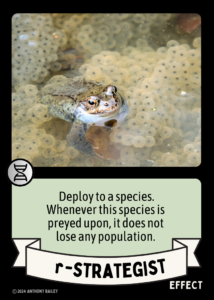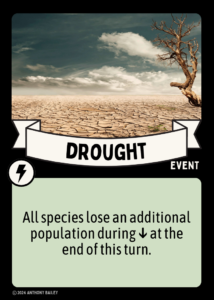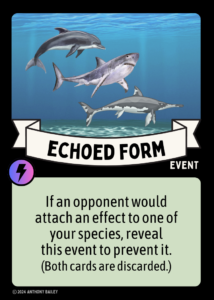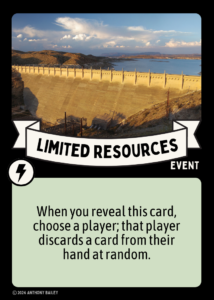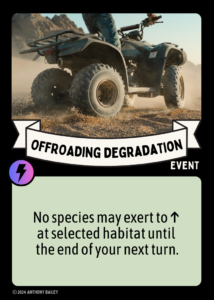Endless Forms:
a biology-based strategy card game
Asombro is proud to present the first edition of Endless Forms, an educational, customizable card game created by Anthony Bailey.
Learn about real organisms and natural science concepts as you collect more than 80 unique cards, or customize a deck to play against an opponent in a dynamic strategy game (game play recommended for ages 12+).
- About
- How to Play
- Asombro Edition
- Card Catalogue
- Contact
Endless Forms is a 2-player strategy card game based on real organisms and natural science concepts. The abilities of Species cards in the game reflect the real-life survival strategies of the animals the cards are named after. Likewise, the consequences of Effect and Event cards mirror the effects of the natural phenomena that they are based upon. By playing the game, players will intuitively learn the roles that these wild organisms, habitats, and biological concepts play in nature.
Educational facts appear on many cards, and players and collectors can learn much more about all 50 cards in the Asombro Edition starter deck by perusing the Card Catalogue.
While kids and adults of any age can enjoy collecting and trading Endless Forms cards, we recommended the game for ages 10 and up. Nature lovers and fans of Pokémon TCG or Magic: The Gathering will find that this game is right up their alley!
Currently, Endless Forms is only available through the Asombro Institute, who is selling this first edition as a fundraiser. Support them by purchasing a starter deck, and follow @EndlessFormsGame on Facebook or Instagram to hear about future releases!

Read the full rule set below, or click a link to download the player’s manual (for print versions, print double-sided on 8.5″ x 11″ paper, fold, and staple):
| Digital Version | Print Version (Color) | Print Version (B&W) |
Basic Concepts
Endless Forms is based on real organisms and natural science concepts. This is a 2-player strategy game where you will draw cards from a shuffled deck and figure out how best to play them. Like other popular card games, you can craft your deck to include the cards that you think will work best together.
Each player has 2 decks: A 10-card habitat deck made up of habitat cards, and a 40-card main deck made up of species cards, event cards, and effect cards. Just as in nature, your goal is to survive and thrive. You will attempt to grow the populations of your species cards (by placing counters like coins or dice on them) as much as possible, while your opponent endeavors to do the same.

At the beginning of the game, habitat cards are drawn and placed in the playing area. Players draw cards from their main deck and take turns placing species cards “in” those habitats. Species may be predators, like a coyote or a rattlesnake, which can only grow their populations if they prey on other creatures. Other species such as insects or songbirds can get what they need (like leaves, nectar, or seeds) from their habitat, so their populations grow automatically. No animal lives forever, so at the end of each turn all populations decline and lose some counters, and if a species’ population reaches zero at this or any time it is removed from the game. The goal of each player is to increase the populations of all of their species as much as possible during each of their 8 turns. The player with the most population counters at the end of the game is the winner.
Species may benefit from their own special adaptations, or from symbiotic relationships with other creatures. Playing effect and event cards can also help your species, or hinder your opponent’s. Using your own creativity and ingenuity to determine where to play your cards, and when, can give you an advantage over the other player, and the cards you choose to include in your deck can give you the best odds of ending the game with the largest population. Exactly which cards you draw, however, is up to chance, meaning no two games will ever be the same!
Rule #1: Break the rules!
While you must learn the rule set below in order to play Endless Forms, the power of your cards comes from the fact that they allow you to break these rules. The text on a card may grant you an exception to one or more of the game’s rules, so read and follow its instructions carefully. If a card contradicts what is in these rules, the card is right!
Card Types
Each player has 2 decks: A habitat deck containing habitat cards, and a main deck containing species cards, event cards, and effect cards.
In this game, every card in your decks must be unique. In other words, you are not allowed to have any duplicate cards unless a specific card (e.g., Chihuahuan Raven) says that you may.
Learn more about each card type below. Terms like “exert” and “predate” are explained in the Phases of a Turn section.
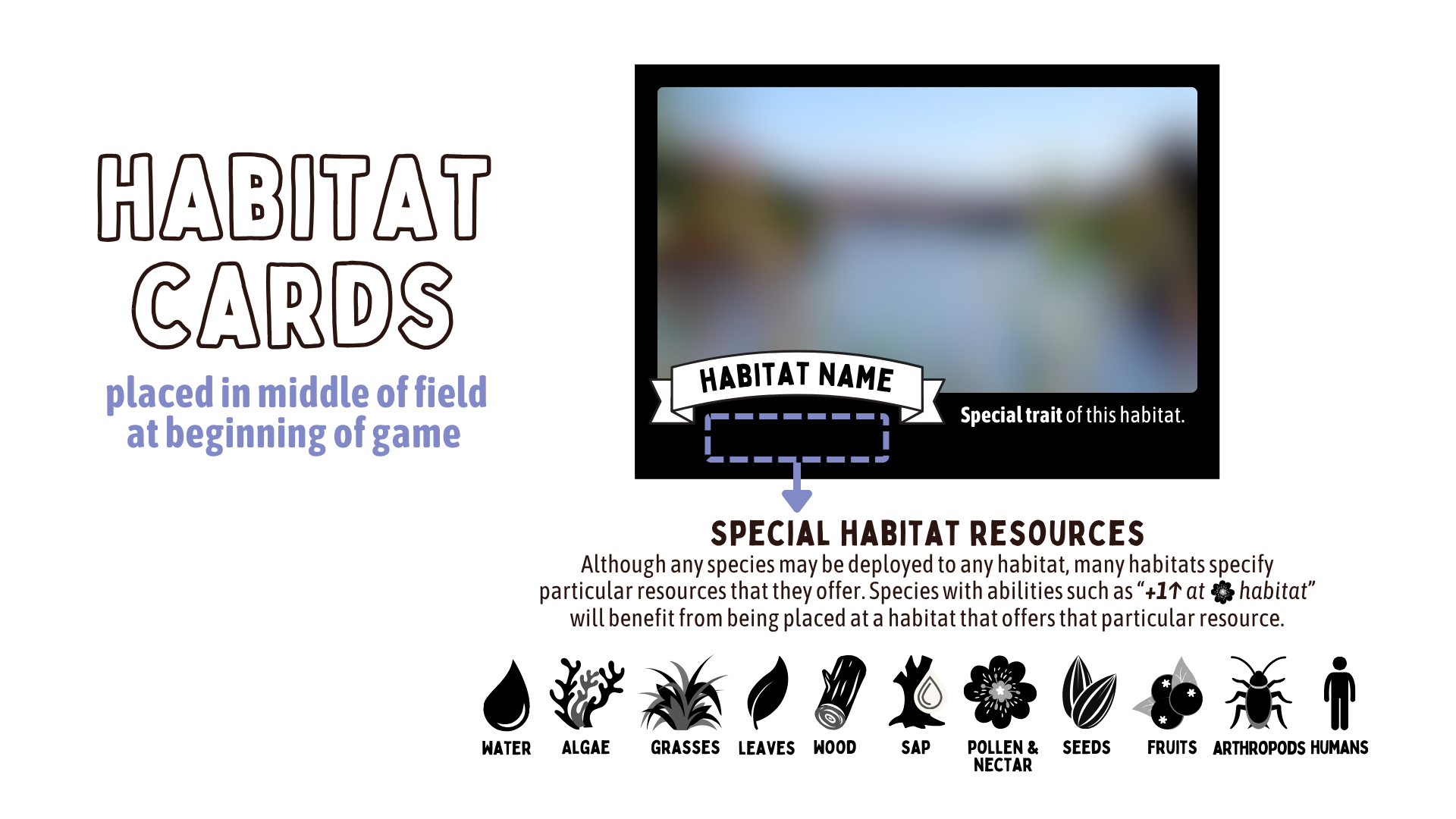



Setting Up To Play
Find a flat surface where you and your opponent can sit facing each other.
You and your opponent each need:
- A 10-card habitat deck made up of habitat cards
- A 40-card main deck made up of species cards, effect cards, and event cards
- Counters, like coins or dice, to keep track of your species’ populations
- A 6-sided die (also known as a D6)
STEP 1: Each player shuffles both of their decks and places them face-down.
STEP 2: Each player draws 8 cards from their main deck. You may look at your own cards in your hand, but you may not look at your opponent’s. Each player decides whether to keep their hand, or draw a new one (see “First hand” in the Tips & Reminders section).
STEP 3: Each player draws 2 cards from the top of their habitat deck and places them face-up in the center of the play area in an alternating pattern, as shown below.
STEP 4: Flip a coin or roll a die to see who will take the first turn.
The diagram below shows the placement of cards for an example game in-progress:
Phases of a Turn
![]()
You and your opponent will each get 8 turns to grow the populations of your species as much as possible. The game alternates between Day and Night, with each player getting one turn during each phase. (Tip: Use this turn tracker, which also appears on the back of the printed player’s manual, to keep track.) The player with the most population counters on their species at the end of 16 turns is the winner.
1 – Initialization Phase
On your first turn of the game, you will simply draw from your main deck during this phase. The game begins as Day so you will draw 1 card. When it is Night, you will draw 2 cards.
If you have already had a turn and have species that have been exerted (i.e., rotated sideways), you should un-exert them (i.e., rotate them back to the normal position) during this phase.
The Initialization Phase in more detail:
- Stage 1: Un-exert any of your exerted species.
- Stage 2: Resolve any cards that reference “At the beginning of turn…”
(i.e., make their effect happen). - Stage 3: Draw cards for the turn: 1 card if it is Day, 2 cards if it is Night.
2 – Deployment Phase
Time to play some cards! During this phase, you may play 1 card of each type:
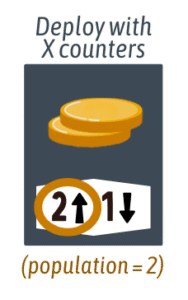
- Species: Species are deployed to habitats. Each player may have a maximum of 3 species at any one habitat. Any species can be deployed to any habitat that has room for it. When you first deploy a species, place as many population counters on top of it as is specified by its population growth rate (X↑, see the Species Cards graphic in the Card Types section above). Take a look at the graphic in the Setting Up To Play section to see how species cards should be placed in habitats on the playing field.
- Effects: Effects may be attached to species cards, habitat cards, or have other consequences as specified by the text on the card. Place them partially underneath the card they are deployed to so that you can remember that their effect is in action. When a card with an effect attached to it is discarded, the effect is discarded along with it. Multiple effects can be attached to a single card.
- Events: Event cards are played face-down in your event card zone. Event cards can be revealed (turned over) at any time during the game, even during your opponent’s turn. When an event card is revealed, it is resolved (i.e., its text takes effect) immediately, and then it must be placed in its owner’s discard pile. You must wait until your next Deployment Phase to place a new event card in your event zone, and only one event card may be in this zone at any given time. More details on event cards:
Events are important because they “interdict”. Event cards can be played at any time and are resolved immediately. Interdiction means that the card takes precedence and may interrupt normal actions. For example, you may intend to play a card to the field, but your opponent can reveal their hidden event just before you do so, requiring that the text of that event card be followed first. The only exception is when the first player also has an event card and plays it “in response” to their opponent’s event. In these cases, follow the “last played, first to resolve” rule. This means that the last event played gets resolved first, followed by the event that was played just before it.
3 – Exertion Phase
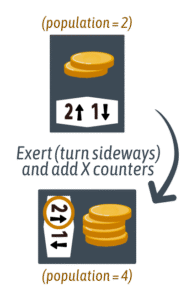
Species must exert themselves at a habitat in order to grow (↑) their populations. When they exert, rotate them sideways and add the number of counters specified by their population growth rate (X↑). Exert as many of your species as possible, but each only once, and only during this phase.
- Predators may only exert if a species of their own size rank or up to 2 ranks lower is present in the same habitat (for example, a predator of rank 4 may predate upon a species of rank 4, 3, or 2). When they exert to predate, they gain X counters, and the selected prey species loses 1 counter. The same prey species can be preyed upon by multiple predators, losing 1 counter for each. You may predate upon your own species, and upon exerted species, so long as they are in the same habitat and are of suitable rank. If a prey species loses its last population counter, the card is moved to its owner’s discard pile. Predator cards are marked with fangs around their size rank number (see the Species Cards graphic in the Card Types section).
- Non-predators may exert to gain X population counters as long as they are at a habitat. Other species do not lose counters when non-predators exert.
4 – Movement Phase
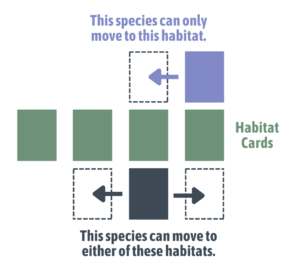
During this phase, you may move 1 species card, including exerted species, to a different habitat if possible. This habitat must be adjacent to (i.e., touching on either side) the habitat the species is currently at, and must have room for it. If you already have 3 species at a habitat, it is full (even if your opponent has space on their side of the field). If you do not wish to move a species, or if no move is possible, proceed to your Termination Phase.
5 – Termination Phase
All species go into decline (↓) and lose some population counters during the Termination Phase of every turn. During your Termination Phase, both you and your opponent must remove as many counters from each species as is specified by their population decline rate (Y↓). If any of your species lose all their population counters at this time or any other, they must be removed from play and placed in your discard pile.
The Termination Phase in more detail:
- Stage 1: Remove Y counters from all species.
- Stage 2: Resolve any cards that reference “At the end of turn…”.
- Stage 3: Pass the turn to your opponent.
Your turn is now over.

Tips & Reminders
General
- You may not have any duplicate cards in any of your decks unless a card specifically says so.
- You may have any number of species, effect, and event cards in your main deck as long as you do not have more than 40 cards total. A recommended balance for new players is: 20 species, 10 effects, and 10 events.
- When you first deploy a species, place as many population counters on top of it as is specified by its population growth rate (X↑).
- During your Exertion Phase, you can exert any of your non-predators at any habitat. Predators, however, can only be exerted if a suitable prey species is present at the same habitat. A suitable prey species is a species of the same size rank as your predator or up to 2 ranks lower (for example, a rank 4 predator can predate upon any species of rank 4, 3, or 2). Predator cards are marked with fangs around their size rank. (In this game, animals that feed on insects and other arthropods are not treated as predators.) When you exert any species, rotate them sideways and give them X population counters.
- When a species is preyed upon, it loses 1 population counter.
- You may predate upon your own species so long as they are in the same habitat as your predator and are of suitable size rank.
- Being exerted does not prevent a species from being moved, or from being preyed upon.
- All species lose Y population counters during the Termination Phase of every turn (yours and your opponent’s). If any of your species lose all their population counters at this time or any other, they must be removed from play and placed in your discard pile.
- Multiple effects can be deployed to the same card.
- Only one event card can be in your event zone at any given time.
- It is important to consider timing when revealing an event card as it can dramatically influence how powerful that event is.
First hand, and hand size
- After you draw your first hand of 8 cards from your main deck, there is no limit to how large or small the number of cards in your hand can be.
- You may choose whether or not to keep your first hand. If you are unhappy with the cards you have drawn, you may shuffle those cards back into the deck and draw a new hand (this process is called a mulligan). In this game, you get 1 free mulligan. After that, if you are still unhappy with your hand, you can repeat the process, but you must draw 1 fewer card each time. Taking more than 2 or 3 mulligans is usually not recommended. A good starting hand will have 1 or 2 effect cards, 1 or 2 event cards, and 4 to 6 species cards. Players must commit to their hands before habitat cards are drawn.
Habitats
- All the species that are deployed to a particular habitat should be placed in a column aligned with that habitat (see the Playing Field graphic in the Setting Up To Play section). The order of species within a habitat column does not matter, but your species should stay on your side of the playing field. Remember that you and your opponent may each deploy a maximum of 3 species to one habitat, so a given habitat can have anywhere from 0 to 6 species in it. A predator in a habitat column can choose any suitable prey species within that column.
- If a habitat is copied, the copy becomes a fresh iteration of that habitat with no effects or counters attached to it.
Turn Tracking
- The “Turn Tracker” graphic in the Phases of a Turn section can help you keep track of whether it is Day or Night, and how many turns remain in the game. The graphic also appears on the back of the print version of the rule booklet. You can use a coin or other object to mark the current turn.
Glossary
Ability: The bold text on a species card that grants it a special power in the game. (E.g., “Keen Eyes: This species may predate in an adjacent habitat.” This also includes text such as “+1↑ at [leaves] habitat”.)
Adjacent: Adjoining or neighboring. If a habitat card is touching another on its right or left side, it is adjacent to that habitat (see Phases of a Turn: Movement section for an example).
Blanched: A term applied to species who have adapted to blend in to a light-colored environment (like White Sands) by becoming more pale in color. See also: Melanic.
Counter: An object like a coin or die that is used to keep track of the size of a species’ population throughout the game. If a species currently has a population of 5, it should have 5 coins on it, or one die showing the value 5.
D6: A six-sided die. If you don’t have one, search “D6 roller” to roll a virtual die.
Day: One of two game phases. The game alternates between Day and Night, with each player getting one turn during each phase. The game starts as Day. If it is Day, you draw 1 card during your Initialization Phase.
Deploy: When you play a card from your hand to the playing field. Species cards are deployed to habitats. Event cards are deployed to your event zone. Effect cards are deployed to another card (place effect cards under the card they are deployed to with the effect name showing underneath).
Effect Card: A card in your main deck that is deployed to (attached to) another card. Its effect remains in place as long as the card is in play.
Event Card: A card in your main deck that is deployed face-down to your event zone. It may be revealed (turned over and enacted) at any time.
Event Zone: The area on your side of the playing field where you play your event card face-down.
Exert: Turning a species card sideways so that it may gain as many population counters as its population growth rate (X↑) specifies. Predators may only exert if a prey species is present in the same habitat (see Prey).
Group: The animal group (or “taxon”) that a species belongs to (e.g., amphibian, reptile, bird, mammal, arthropod).
Habitat Card: The only type of card in your habitat deck. Placed in the center of the playing field. Any player can deploy up to 3 species to any habitat.
Habitat Deck: Your 10-card deck of unique habitat cards.
Herbivore: An animal who eats plants.
Initialization Phase: The first phase of your turn during which you draw a card and un-exert your species.
Main Deck: Your 40-card deck composed of species cards, effect cards, and event cards (all unique).
Melanic: A term applied to species who have adapted to blend in to a dark-colored environment (like a lava flow) by becoming darker in color. See also: Blanched.
Movement Phase: The second-to-last phase of your turn during which you may move 1 deployed species to an adjacent habitat.
Mulligan: Process during which a player changes out the cards in their first hand at the beginning of the game. See “First hand” in Tips & Reminders section.
Night: The game alternates between Day and Night, with each player getting one turn during each phase. If it is Night, you draw 2 cards during your Initialization Phase.
Population: The number of population counters a species currently has. “A population” means 1 population counter.
Predate: When a predator is exerted in a habitat. When this happens, the predator gains X counters, and the selected prey species loses 1.
Predator: A carnivorous species that must eat other animals to survive. These cards are marked with fangs around their size rank number. In order to exert to grow their population, a predator must select a suitable prey species at the same habitat (see Prey).
Prey: A prey species for a particular predator is one that is at the same habitat and has a size rank equal to that predator or up to 2 sizes smaller. For example, a predator of rank 5 may choose to predate upon another species of rank 5, 4, or 3.
Rank: see Size Rank
Resolve: A card is resolved when its text has taken effect.
Size Rank: A number that appears on every species card that indicates its size (1 being the smallest). Rank matters when predators are selecting prey (see Predator, Prey).
Special Habitat Resources: The symbols that appear on habitat cards. Species with abilities like “+1↑ at [sap] habitat” get more population counters when they exert at habitats with these symbols.
Species Card: A card in your main deck that is deployed to a habitat if possible. Species must be exerted during their owner’s Exertion Phase in order to gain population counters. The player with the most counters on their species at the end of the game wins.
Termination Phase: The final phase of your turn during which all species lose as many population counters as their population decline rate (Y↓) specifies.
Trait: See Special Habitat Trait
Un-exert: Turning a species card right-side up during your Initialization Phase so that it is ready to exert again.
X↑ : The population growth rate of a particular species. This number appears next to an up arrow (↑) on every species card. When a species is first deployed to a habitat, or is exerted in that habitat, place X counters on it.
Y↓ : The population decline rate of a particular species. This number appears next to a down arrow (↓) on every species card. At the Termination Phase of every player’s turn, Y counters are removed from the card.
↑: Growth, or grow (e.g. “exert to ↑” can be read as “exert to grow”). Population growth occurs during the Exertion Phase of each player’s turn, and is when counters are added to species cards.
↓: Decline (e.g. “during ↓” can be read as “during decline”). Population decline occurs during the Termination Phase of every turn, and is when counters are removed from species cards.
Need More Help?
If you have a question about a rule or specific game scenario, or have any other questions, comments, or feedback, don’t hesitate to contact us. We’d love to hear from you!
Send an email to EndlessFormsGame@gmail.com
Message us on Facebook or Instagram.
© 2024 Anthony Bailey
The first edition of Endless Forms, created especially for the Asombro Institute, is based on the incredible flora & fauna of the Chihuahuan Desert. Cards in this set feature the unique organisms and habitats found in this diverse region. For example, the Coyote and the American Badger can be played to the same habitat to cooperatively hunt together, and camouflaged species like the Creosote Bush Walking Stick and the Roundtail Horned Lizard can avoid such predation.
Ready-to-play starter decks of this first edition of Endless Forms are currently being printed and sold by Asombro as a fundraiser, with all proceeds benefitting their vital mission. Attend one of Asombro’s public events to buy decks and accessories in person, or place an order online.

Learn more about the real organisms, habitats, events, phenomena, and natural science concepts behind all 50 cards in the Asombro Edition starter deck.
Read below, or click a link to download the starter deck catalogue (for print versions, print double-sided on 8.5″ x 11″ paper, fold, and staple):
| Digital Version | Print Version (Color) | Print Version (B&W) |
| Species | |
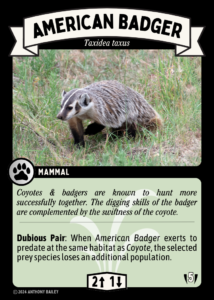 | American Badger (Taxidea taxus): North America’s only badger, this carnivore is common throughout the western and central U.S. as well as Mexico. Its powerful arms and long claws are specialized for digging prey like small mammals & reptiles out of their underground shelters. Abandoned badger burrows and excavations provide important living spaces for many other animals, such as burrowing owls. Interestingly, badgers and coyotes have often been observed hunting in tandem. Coyotes may lead badgers to prey that they have chased into a burrow, which the badger can then dig up. Dubious Pair: When American Badger exerts to predate at the same habitat as Coyote, the selected prey species loses an additional population. |
 | American Kestrel (Falco sparverius): The smallest falcon in North America, these birds are often seen perched on power lines or telephone poles, searching the ground below for prey. They can also do this while in mid-air, constantly flapping to hover above the ground while keeping their head and eyes steady. Males have slate gray wings and rusty red backs. Both sexes have black vertical stripes or “sideburns” on their light-colored heads. These birds have a varied diet and live in a range of habitats. They are common year-round in the Chihuahuan Desert. Keen Eyes: This species may predate in an adjacent habitat. |
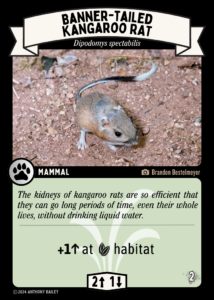 | Banner-tailed Kangaroo Rat (Dipodomys spectabilis): Neither rats nor kangaroos, these nocturnal rodents do not scurry but rather hop to move from place to place, the white tips of their tails waving as they do so. They forage primarily for seeds which they carry in pouches in their cheeks. They cache (or store) large numbers of these seeds in their burrows, which are noticeable as mounds on the surface. These large kangaroo rats defend their territory from others of their kind by standing on top of their mounds and drumming their feet on the ground. (Special thanks to Brandon Bestelmeyer for sharing the photo featured on this card.) +1↑ at [seeds] habitat |
 | Black-chinned Hummingbird (Archilochus alexandri): Widespread in the western U.S. and Mexico, males have a dark head with a strip of iridescent feathers on their throats that shines purple in the sunlight. At rest, their hearts beat around 500 times a minute. When feeding on flower nectar, they perform about 15 licks per second, and in the winter can consume three times their body weight in a single day. If nectar is not available, they can survive by eating insects. Though small, these birds can travel over 1,000 miles during their migration to Mexico each fall. +1↑ at [flowers] habitat +1↑ at [arthropods] habitat |
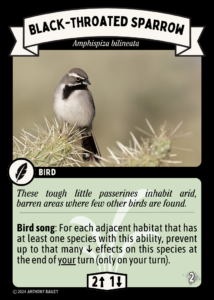 | Black-throated Sparrow (Amphispiza bilineata): If you find yourself in a seemingly lifeless stretch of desert scrub, listen for the metallic, tinkling calls of these striking little sparrows. Distinguished by two bold white stripes on their heads, these are often the only birds you’ll encounter in many of the hottest, driest areas of the Chihuahuan Desert. Groups stay near the ground, calling to one another as they hop from bush to bush in search of insects. Bird song: For each adjacent habitat that has at least one species with this ability, prevent up to that many ↓ effects on this species at the end of your turn (only on your turn). |
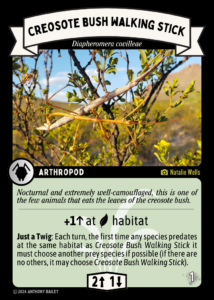 | Creosote Bush Walkingstick (Diapheromera covilleae): This insect is one of the few animals that eats the leaves of the creosote bush, a plant with which it blends in superbly. As juveniles, their bodies are a bright green, matching the creosote’s fresh leafy stems. They then mature to a dull brown or orange, just like the shrub’s older branches. In addition to looking like a stick, they also try to behave like one, walking with a swaying side-to-side motion in order to appear like a windblown stem. A male (orange) and a female (larger and gray) can be seen in the photo on this card. (Special thanks to Natalie Wells for sharing the photo featured on this card.) +1↑ at [leaves] habitat Just a Twig: Each turn, the first time any species predates at the same habitat as Creosote Bush Walking Stick it must choose another prey species if possible (if there are no others, it may choose Creosote Bush Walking Stick). |
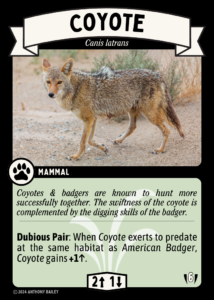 | Coyote (Canis latrans): Intelligent and opportunistic, these canines have keen senses and are mostly nocturnal. Pairs often remain mates for many years, raising young together, and family groups may stay together in packs. The yaps and howls heard in the desert at night are often a pack’s way of maintaining its territory. The Coyote has a special relationship with the American Badger: both are often observed hunting together. Coyotes may lead badgers to prey that they have chased into a burrow, which the badger can then dig up. This arrangement appears to benefit them both. Dubious Pair: When Coyote exerts to predate at the same habitat as American Badger, Coyote gains +1↑. |
 | Chihuahuan Raven (Corvus cryptoleucus): Like the American Crow and Common Raven, the Chihuahuan Raven is intelligent and social, but it is better than both at surviving in dry environments. These omnivores are not picky eaters, foraging for a variety of plants, insects, roadkill, and occasionally live vertebrates. Pairs perform lively, acrobatic flights together and often remain mated for life. This species is found in southern Arizona, New Mexico, Texas, and a large portion of Mexico. The oldest recorded wild Chihuahuan Raven was 21 years old. Mated Pair: You may have 2 cards named Chihuahuan Raven in your starting deck. If Chihuahuan Raven is at a habitat with another card named Chihuahuan Raven it gains +1↑. |
 | Gray Vireo (Vireo vicinior): Another tough resident of some of the hottest regions in the southwest, the songs of these small gray passerines are heard throughout the spring. They forage for insects in bushes and trees as well as on the ground, and are known for flicking their tails as they move about. While the female builds a functional nest, the male sometimes builds a more primitive one nearby. These “bachelor nests” are not used but may function as decoys, or simply form part of the pair bonding process. The Gray Vireo is a Species of Greatest Conservation Need in New Mexico. +2↑ at [arthropods] habitat Bird song: For each adjacent habitat that has at least one species with this ability, prevent up to that many ↓ effects on this species at the end of your turn (only on your turn). |
 | Greater Earless Lizard (Cophosaurus texanus): These heat-loving lizards are a common sight in the Chihuahuan Desert, even during hot summer days. They are often seen perched on rocks keeping watch over their territory and looking for insect prey. Their black-banded tails curl high over their bodies when they run, helping them to scurry even faster and providing a distraction to any pursuers. While the name suggests otherwise, earless lizards do in fact have ears – their external openings are simply covered with scales to keep them free of dirt. Hot-Footed: If this species would be predated upon, it may move to an adjacent habitat to cancel it once per turn. |
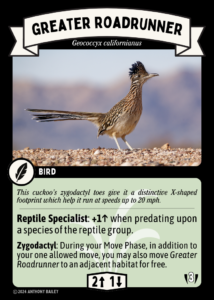 | Greater Roadrunner (Geococcyx californianus): An iconic resident of the American southwest, the roadrunner is not only fast but fierce. These birds are capable of killing and eating rattlesnakes, scorpions, and even the horned lizard, which they consume head-first so as not to be harmed by its bony spikes. While capable of flying, they prefer to run, leaving distinctive X-shaped footprints behind. These expressive birds use their feathers, colors, and wide range of vocalizations to defend their territory and court a mate, which they will keep for their entire lives. Reptile Specialist: +1↑ when predating upon a species of the reptile group. Zygodactyl: During your Move Phase, in addition to your one allowed move, you may also move Greater Roadrunner to an adjacent habitat for free. |
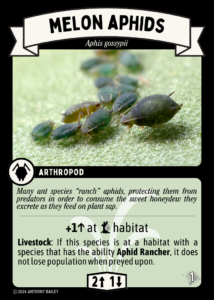 | Melon Aphids (Aphis gossypii): Also known as the cotton aphid, this insect is found across much of the world. It feeds on a large number of plants in addition to melons and cotton. Like all aphids, it drinks sap from leaves and stems through its sharp, straw-like mouth. Aphids drink so much sap that the waste they produce, called honeydew, still contains valuable sugars and nutrients which other animals can make use of. For this reason, many species of ants have mutually beneficial relationships with aphids, protecting them from predators in exchange for a steady supply of food. +1↑ at [sap] habitat Livestock: If this species is at a habitat with a species that has the ability Aphid Rancher, it does not lose population when preyed upon. |
 | Mexican Honeypot Ants (Myrmecocystus mexicanus): From the surface, the anthill of the honeypot ant looks like any other, with ordinary-looking worker ants scuttling to and fro. However, below the ground in dark chambers, giant ants that function as living food containers can be found hanging silently from the ceilings. These special members of the colony, called repletes, have bodies specialized for storing large volumes of liquid food, which they can then regurgitate if a colony member requests a meal. In this way, the hive can store excess food when times are good, and then use it nourish the colony when resources are more scarce. (Special thanks to Alex Wild for sharing the photo featured on this card.) Stockpiling: If something would prevent this species from exerting to ↑, it may do so anyways. Aphid Rancher: If this species is at a habitat with an aphid species when it exerts, it gains +1↑. |
 | Monarch Butterfly (Danaus plexippus): Monarch butterflies cannot survive the cold North American winters, so those that are born in the fall must begin an epic migration south. Without prior experience, this generation navigates thousands of miles to mountain ranges in central Mexico where they wait out the winter. Come spring, they feed, reproduce, and die. Their offspring then begin the return journey north, but they only complete part of the trip, leaving behind their own young to complete this multi-generational migration – the only one of its kind known among butterflies. +1↑ at [flowers] habitat Exceptional Migration: This species may move to any habitat during movement. |
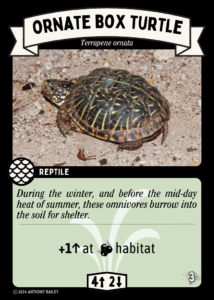 | Ornate Box Turtle (Terrapene ornata): The Ornate Box Turtle spends its days foraging for plants and insects throughout its range in the south-central U.S., where it has adapted to living far from water. It spends the winter, as well as hot summer days, underground. The box turtle’s shell, like all turtles, is part of its skeleton. The top piece, or carapace, is made of flattened, joined ribs with the spine fused to its underside. The bottom piece, or plastron, is made up by joined ribs and the sternum. The shell is covered with keratin, the same material that makes up your fingernails. +1↑ at [fruits] habitat |
 | Oryx (Oryx gazella): The oryx, or gemsbok, is a species of antelope native to the Kalahari Desert in southern Africa. The only other place in the world that wild oryx can be found is in southern New Mexico, where the species was introduced for sport hunting in 1969. Oryx can survive long periods without water and in New Mexico do not have many natural predators, which means their population has swelled to many thousands. Scientists are still working to understand the impacts of these newcomers, but overgrazing, outcompeting native species, and increased danger of vehicle collisions are present concerns. Invasive Species: If this species moves during your Move Phase, it loses one less population during ↓ on your Termination Phase. |
 | Roundtail Horned Lizard (Phrynosoma modestum): This small horned lizard, or “horny toad”, is particularly well-camouflaged for desert environs. In addition to the earthy colors of its scales, this lizard rounds its back and closes its eyes to appear like a rock. Like other horned lizards, it specializes in eating ants. A summer walk in the desert is likely to put you in the path of a horned lizard, but if they don’t move, you’ll be hard-pressed to spot them! (Special thanks to Natalie Wells for sharing the photo featured on this card.) Ant Specialist: May predate upon any ant species at the same habitat as if it were a predator. Just a Rock: Each turn, the first time any species predates at the same habitat as Roundtail Horned Lizard it must choose another prey species if possible (if there are no others, it may choose Roundtail Horned Lizard). |
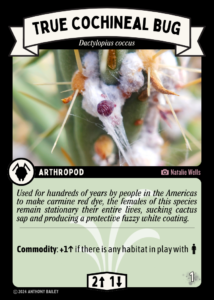 | True Cochineal Bug (Dactylopius coccus): There is a long and fascinating story behind the white “fuzz” often seen on prickly pear cacti. Underneath are tiny red bugs related to aphids and other scale insects. These bugs feed on cactus sap and produce the white material to protect themselves from the sun. Females are wingless and live their entire lives in the same spot. Native peoples in Mexico developed a process to collect, dry, and crush cochineal in order to make a vibrant red dye known as carmine. This pigment was coveted by Europeans, whose used it to dye the scarlet uniforms of Catholic cardinals as well as the famous British “redcoats.” (Special thanks to Natalie Wells for sharing the photo featured on this card.) Commodity: +1↑ if there is any habitat in play with [humans]. |
 | Turkey Vulture (Cathartes aura): Turkey Vultures live across the U.S. and perform an essential service. By using their keen senses of smell and sight, they locate and clean up carcasses that would otherwise sit, accumulate, and spread disease. Between their association with death, and their bare faces (which help them stay clean), these buzzards often get a bad rap. In reality, they should be appreciated for helping to keep our ecosystems clean and healthy. Carrion Feeder: In order to play Turkey Vulture, choose one species in any player’s discard pile and remove it from the game. Scavenger: Turkey Vulture may only exert to ↑ if another species predates at the same habitat. Turkey Vulture may do this during any player’s Exert Phase. |
 | Western Hognose Snake (Heterodon nasicus): The Western or Plains Hognose Snake is found across the central U.S. Their distinctive “nose” is a modified scale which helps them dig in loose soil as they look for shelter and food. These snakes specialize in hunting toads, and have a natural resistance to the toxins found in their skin. Hognose snakes are famous for their dramatic acting. If threatened, they may flatten their heads, puff their bodies, hiss, and pretend to strike. They are also known to play dead by flipping upside down with their mouths hanging open, and soiling themselves for added effect. Feign death: If this species reaches 0 population, it does not go to the discard pile. Instead, it remains in play as normal. |
| Habitats | |
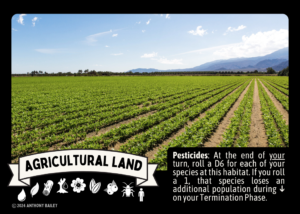 | Agricultural Land: People have learned ways to grow many different kinds of crops over very large areas, even in regions that receive little rainfall. These swaths of land can provide resources to local wildlife that they would not naturally have access to, but this comes at a price – crop land replaces native habitats, and the pesticides used can harm native organisms and environments. Pesticides: At the end of your turn, roll a D6 for each of your species at this habitat. If you roll a 1, that species loses an additional population during ↓ on your Termination Phase. |
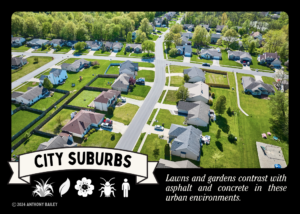 | City Suburbs: Humans bring many plants, whether for food or decoration, along with them when they settle in a new place. In this way, the green parts of towns and cities can feature a wide array of both native and non-native plants, creating a diverse artificial habitat for other organisms. In some cases, however, introduced species spread and harm native ones. |
 | Creosote Scrub: The creosote bush, also known as rainbush, is one of the most dominant plants in the Chihuahuan Desert. Its small leaves help reduce water loss and are responsible for the fresh and fragrant smell of the air after rainfall in this region. Pictured on this card is an expanse of typical creosote shrubland near Las Cruces, NM, with the Organ Mountains visible in the background. |
 | Desert Arroyo: With little topsoil, sparse vegetation, and rain that comes in short, intense bursts, water tends to flow swiftly across desert landscapes, rather than soaking into them. The low, sandy channels where water tends to flow during and after a thunderstorm are known as arroyos. Along the banks of arroyos, you’ll find a community of plant life not seen in adjacent areas. |
 | Desert Grassland: Grasslands in the Chihuahuan Desert are home to many unique species and are an important wintering ground for migratory birds. However, due in part to overgrazing and climate change, they are an increasingly rare sight in this region. Protection and further study of these habitats will be critical if they are not to disappear altogether. |
 | Desert Playa: After a summer monsoon rain, water collects in flat desert basins to form short-lived pools called playas. An entire ecosystem springs up during the few weeks that the water remains. Crustacean eggs laid in the playa the previous year hatch when the water returns. Seeds sprout, toads emerge from underground burrows nearby, and snakes and birds arrive to drink and feed at this temporary oasis. (Special thanks to Owen McKenna for sharing the photo featured on this card.) Ephemeral: This habitat comes into play with 6 counters on it. During each Initialize Phase, remove 1 counter. When you remove the last counter, replace this habitat with a new one from its owner’s habitat deck. |
 | Gypsum Flats: While sand dunes are not uncommon in the flat closed basins of the Chihuahuan Desert, White Sands National Park in New Mexico is unique in the world as the largest gypsum dune field of its kind. Formed only about 7000 years ago, a unique community of plants and animals has since adapted to this new environment, including “blanched” species with light coloration to match the pure white terrain. Ecological Speciation: Blanched-type species at this habitat lose one less population during ↓ on their owner’s Termination Phase. |
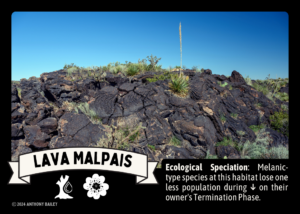 | Lava Malpais: Just around 30 miles north of White Sands, New Mexico is another recently-formed landscape. This lava field, with its pitch black volcanic rock, could perhaps not be more different than the soft white dunes found to the south. However, it too has been the site of adaptation by wild organisms, with “melanic” species of darker complexion finding success among the black boulders. Ecological Speciation: Melanic-type species at this habitat lose one less population during ↓ on their owner’s Termination Phase. |
 | Ocotillo Foothills: Often found on rocky hillsides or slopes, the spiny ocotillo is well-adapted to dry desert environments. Its red flowers, a favorite of hummingbirds, appear at the tip of each of its arms in the spring. Small deciduous leaves grow in response to rain, and then fall during periods of dry weather in order to reduce water loss. When leafless, photosynthesis takes place in the stems. |
 | River Bosque: Desert rivers like the Rio Grande form corridors of lush vegetation that cut through the otherwise arid landscape, providing important habitats and resources for aquatic animals and migrating birds. The cottonwood trees and willows that the river supports make up what is known as the “bosque” (“forest” in Spanish). These special ecosystems have been significantly diminished by human activities. |
© 2024 Anthony Bailey
| Keep up with the latest game updates by following EndlessFormsGame on Instagram and Facebook, and by subscribing to our newsletter! | For questions or comments about the game, feel free to message us on social media, or send an email to EndlessFormsGame@gmail.com. We’d love to hear from you! | For inquiries about how to purchase Endless Forms, click here. |










